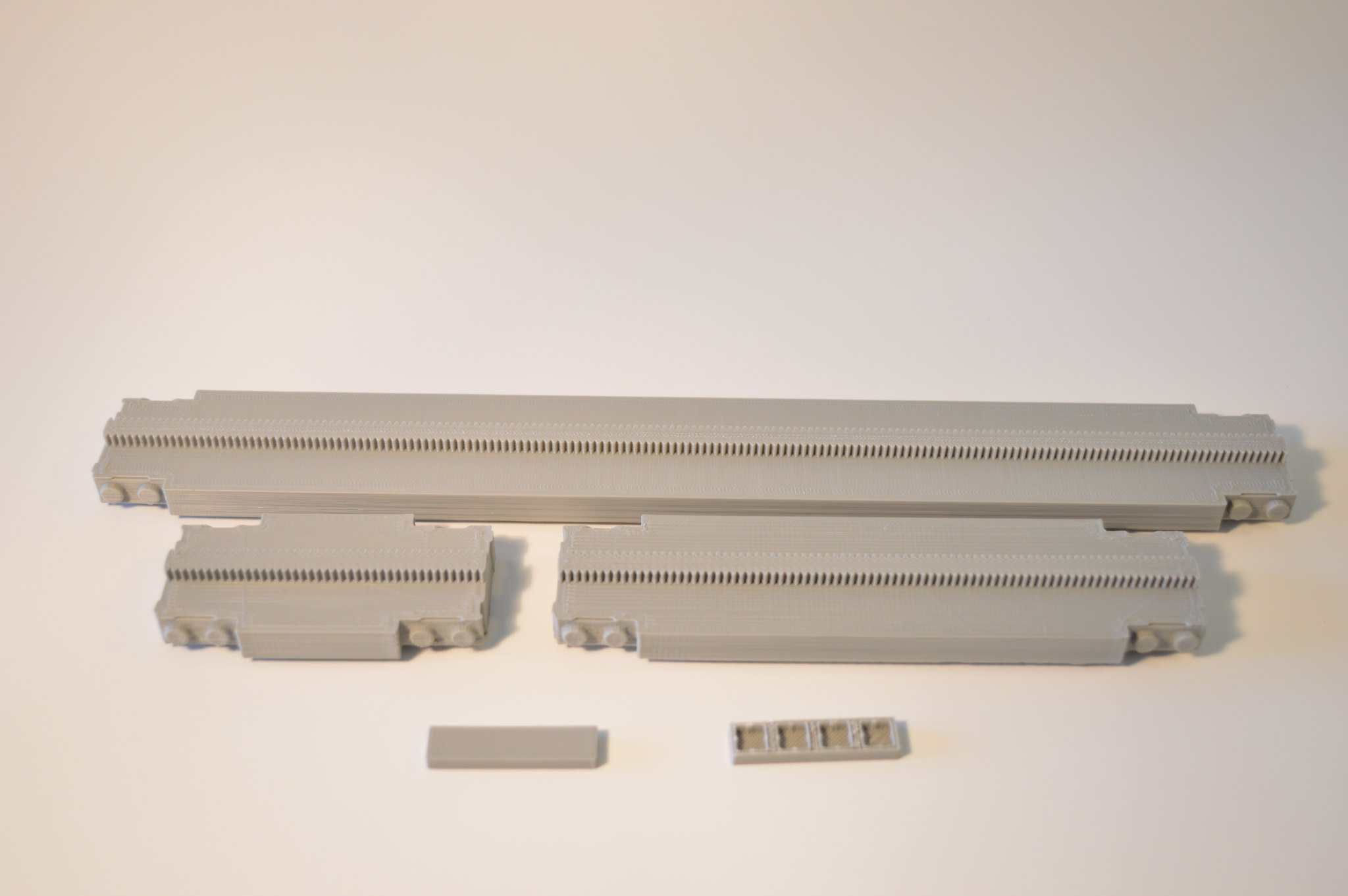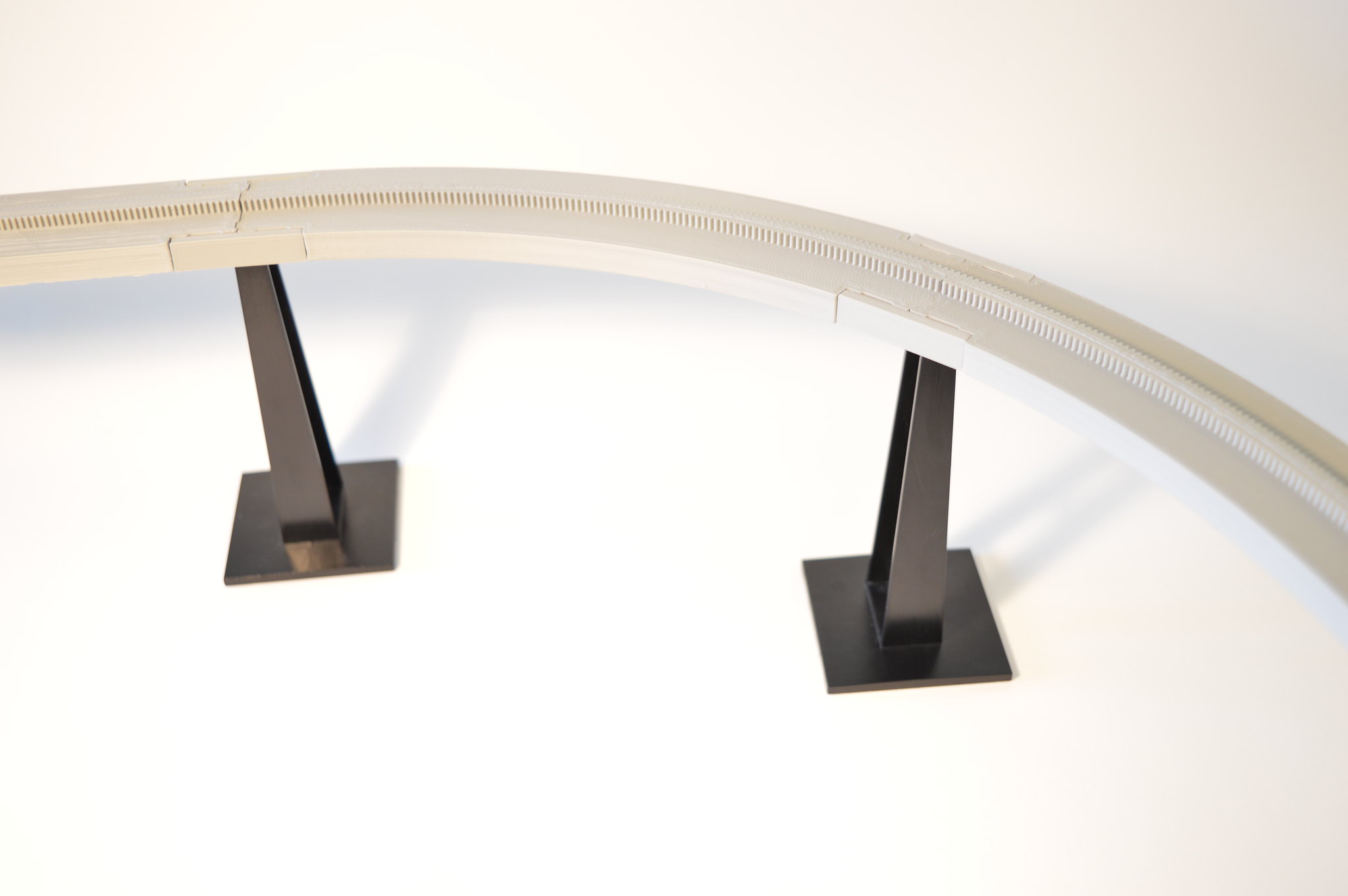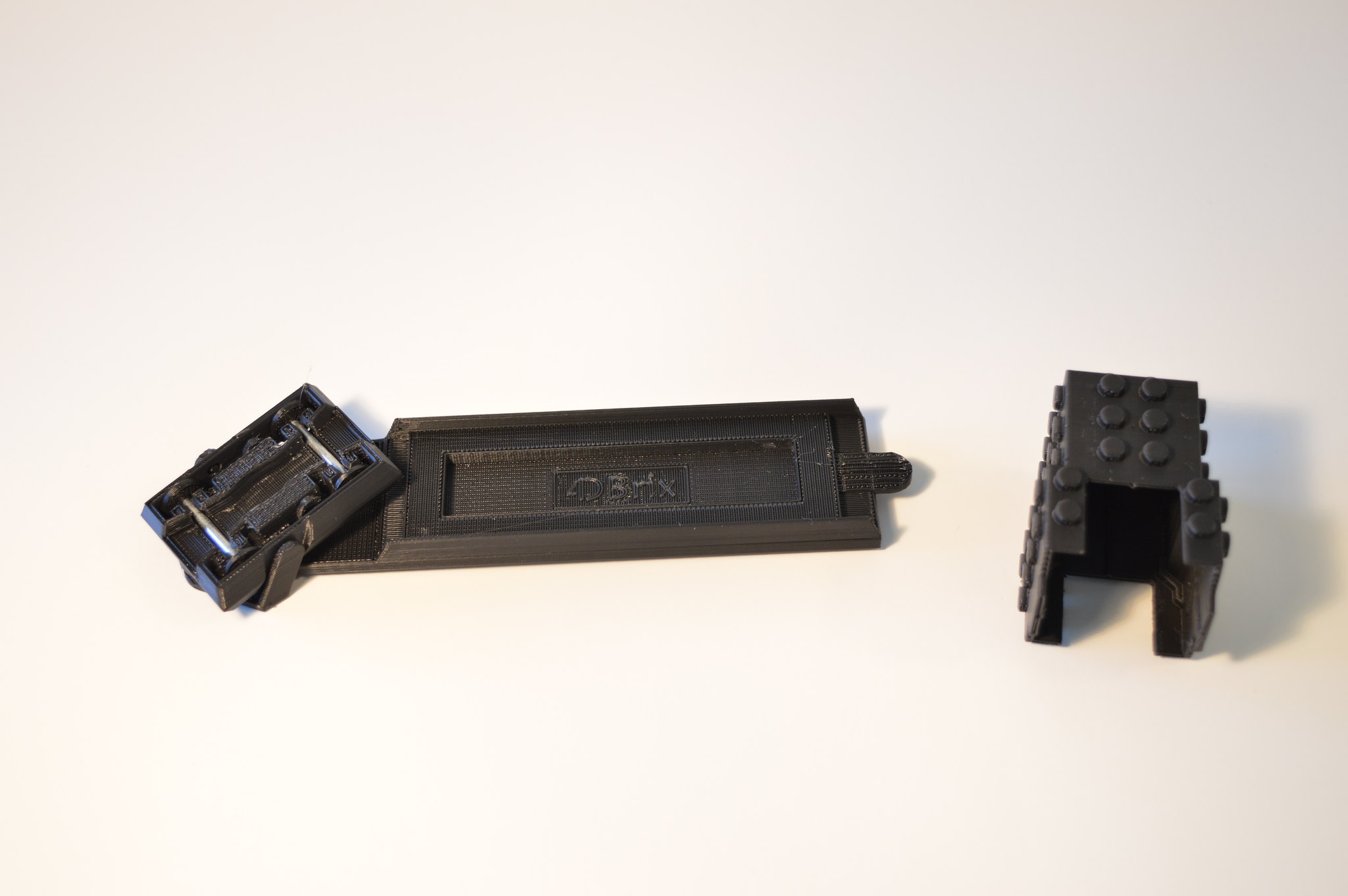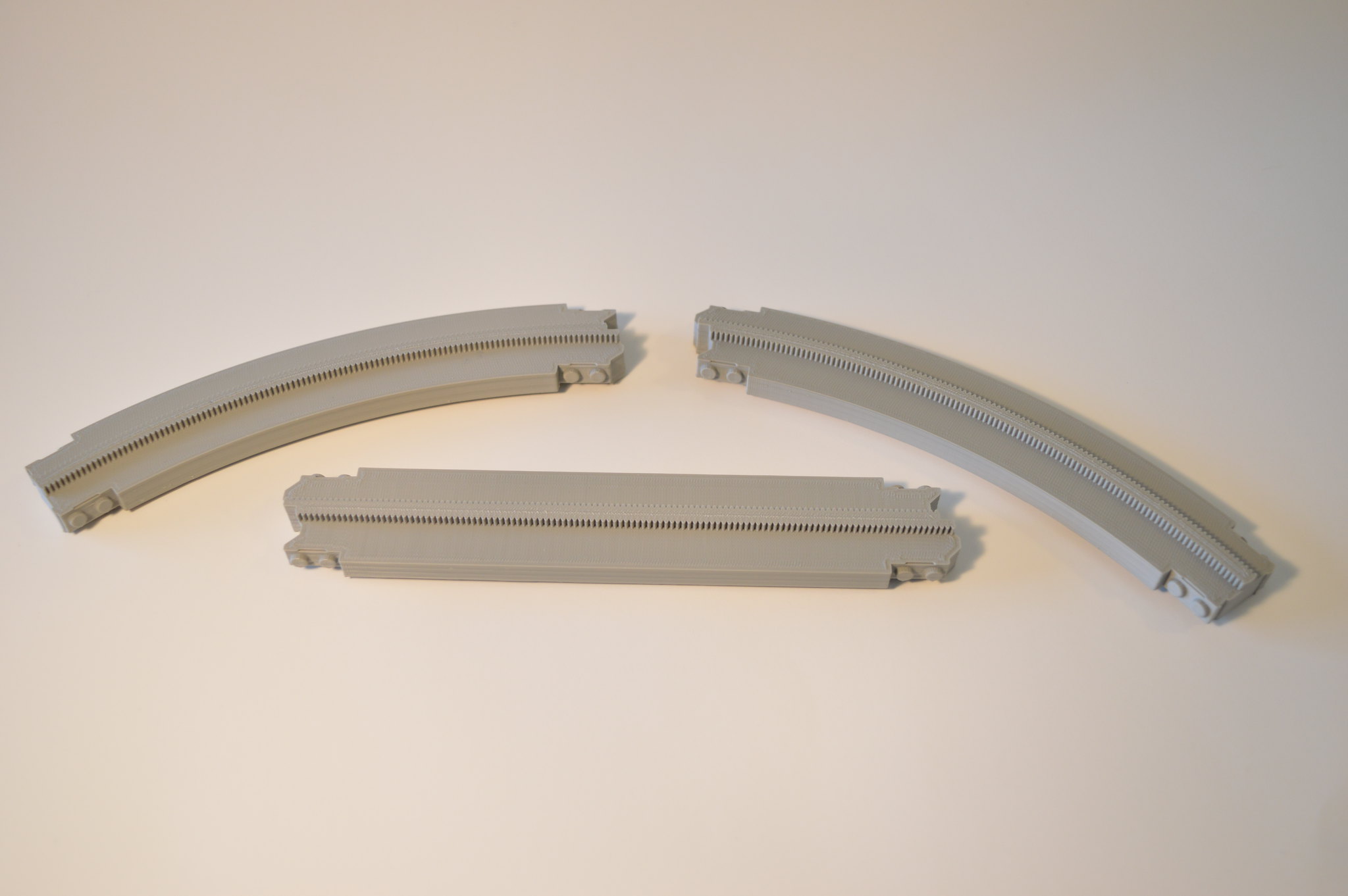Bringing Back the Monorail- 3D Printed!
Posted by SprinkleOtter,
One of the most sought-after systems made by LEGO is the Monorail. These futuristic trains were featured in a mere three sets, from 1987 to 1994. Like most LEGO sets from this timeframe, Monorails have skyrocketed in price, with single pieces of track going for over $20 a piece (if you can find them)!
One member of the Brickset community has decided to change that, creating 3D-Printed versions of classic Monorail parts, as well as parts that LEGO planned to make, but never did. How do they stack up to the originals? Read on below to see what I think.
You are probably wondering, like I did, if this is legal. Surely LEGO must have some sort of patent or copyright on these parts? Actually not- given their age and poor performance back in the day, LEGO never renewed their rights to these parts, and they became fair game. These parts are also not just a copy of existing LEGO parts, but a recreation of a system that LEGO let die, with both old parts being remade, and new parts being added.
Quality:
 One big question on anything 3D printed is what quality it is, so I'll address that first. The owner of 4DBrix assures me that these parts are made with very high-quality 3D printing processes and ABS plastic- and it shows. Monorail motors run smoothly along these tracks just as they would with LEGO tracks. Connecting these parts with standard LEGO parts is also perfectly fine. When viewed from above, these parts look practically the same as the originals. The only differences must be viewed very closely: 3D printing has given these parts tiny ridges instead of the completely smooth feel of molded ABS. Underneath, one can see that the 4DBrix track is solid (unlike the cross-braced LEGO track), meaning they are a little stronger. A few imperfections can be seen on the underside of the track, but I don’t know why the track would ever be set up upside-down, so they don’t bother me. The undersides of the track also come with the same 2x2 connection points as LEGO track did, so you can mount your monorail track on stanchions, for multiple levels of track.
One big question on anything 3D printed is what quality it is, so I'll address that first. The owner of 4DBrix assures me that these parts are made with very high-quality 3D printing processes and ABS plastic- and it shows. Monorail motors run smoothly along these tracks just as they would with LEGO tracks. Connecting these parts with standard LEGO parts is also perfectly fine. When viewed from above, these parts look practically the same as the originals. The only differences must be viewed very closely: 3D printing has given these parts tiny ridges instead of the completely smooth feel of molded ABS. Underneath, one can see that the 4DBrix track is solid (unlike the cross-braced LEGO track), meaning they are a little stronger. A few imperfections can be seen on the underside of the track, but I don’t know why the track would ever be set up upside-down, so they don’t bother me. The undersides of the track also come with the same 2x2 connection points as LEGO track did, so you can mount your monorail track on stanchions, for multiple levels of track.
Coloring:

I am pleasantly surprised that the coloring of this track matches Old Stone Grey perfectly. In addition to old grey, 4DBrix makes monorail track in black and white. The Black monorail track is perfect for a Blacktron monorail MOC, which I see myself doing sometime in the future. Initially, I thought that white monorail was a little silly- white is fairly close to old grey, and that they wouldn’t look very different. Now that I have them side-by-side, I see that I was wrong. White looks very different from old grey, and would blend in very, very nicely in a snowy landscape.
Parts:
Straight track:

Straight track is one of the most expensive parts to get in any LEGO train, and Monorails are no different. 4DBrix currently makes three lengths of straight track, quarter, half, and full lengths. I found these give a great level of flexibility when setting up tracks. Also in the picture are a pair of 3D printed 1x4 tiles, to use to connect the track sections.
Curves:

4DBrix currently produces two short curve sections, left and right. Don’t let their peculiar shape fool you- there is a reason for that shape. When mounting the monorail track off the ground, the joints of the track must have a support underneath them, or the heavy train will cause the tracks to snap apart. The easy solution would then be to place two studs of each track on the support. However, this would lead to the support being at a 45 degree angle with the rest, making it impossible to place the setup on baseplates. The solution is quite clever, it strange-looking, with a zig-zag end and two studs on each side. The good news is, unlike LEGO, 4DBrix produces a curve extension part, that allows you to place a straight section in between two half-curves, for a larger curve.

Unfortunately, 4DBrix does not produce a large curve piece at the moment. While this is unfortunate, large LEGO curves are fairly cheap on Bricklink (about $5 each), so I guess it simply does not make sense to 3D print them at this point.
Train parts:

The extension car is quite a nifty invention- it allows you to add extra cars to the monorail, instead of just having it be two cars and a motor. The motor cover is also quite nice for a city display like 6399, but I don’t feel like it is very necessary for a Space setup- the motor looks quite Space-y by itself. Nonetheless, the motor cover fits quite snugly, and is great for decorating, with studs on five sides.

Original track:

The cream of the crop, for me, is the Cross Switch part. Because the standard cross track style for trains is out of the question for monorail, a different cross piece had to be invented. This simple mechanism has a rotating section of track in the middle, that switches between two incoming tracks. The rotation can either be done manually via a knob, or a motor can be hooked up to the track to automate it. A custom servo motor to power this is also in the works, I hear. But for now, Power Functions will work.
4D Brix also makes ramp track sections. I do not have any on-hand, but given how impressed I was with the other track, I find it hard to believe they would disappoint.
Value:

One of the main selling points of this track is the price. While a long straight track section would cost ~$22 of Bricklink, they cost only $12.45 from 4DBrix. The motor cover would cost you ~$50 on Bricklink, but only $20 in 3D Printed form. Since it is hard to find multiple pieces of track from the same seller on Bricklink, it is even cheaper to buy them from 4DBrix, as you would only have to pay for shipping once.
These are my views on 3D Printed monorails. What are yours? Let us know below, and enjoy these fun facts:
- The LEGO short monorail track has 41 teeth on each side.
- The LEGO monoswitch (half a long monorail) has 82 teeth on each side.
- A long LEGO monorail has 163 teeth on each side. I have no idea why it has one tooth less then what you would expect from the quarter and half.
- a 4DBrix 3D printed track consists of 68 layers of plastic
- it takes almost 6 hours to make one full straight 3D printed monorail track
- 1 full straight monorail track takes 21m / 70 feet of ABS filament
- the print head travels about 400 meter / 0.25 miles for one full straight monorail
Thanks to community member Lowa all his hard work!
37 likes
35 comments on this article
Very interesting. I have my Space Monorail still packed up in a box ready to go. Nice to know I can expand it without the cost of getting pieces then hard way.
These are awesome. I was too young (and poor) to get a monorail, one day I would love one even if it's 3D printed.
The cross track is very neat, but it does bring up, whatever happened to the cross section of the regular train? As far as I know there hasn't been one released for the current Power Systems. I have a 9v one, but I'd love for a cheap plastic one to go with the Passenger Train I just bought.
"Old Stone Gray" is a weird and slightly confusing term for old gray, considering that it blends the fairly unambiguous "old light gray" with the "stone" descriptors Lego uses for the new, bluish grays.
In any case, I'm happy that these are seemingly good enough to serve the purposes of monorail enthusiasts. I imagine that advances in 3D printing and other similar manufacturing techniques will continue to be a huge boon to fans of all sorts of long-retired or hard-to-find parts in the future.
I wonder why TLG doesn't want my money for rereleasing classic sets. Did they lose the molds or what is the problem?
"Is there a chance the track could bend?"
@redrabbit.
Supply/demand kinda thing. TLG has been barely able to keep up with demand for its current products at the moment, let alone branching out into old stuff with only a few buyers. And they don't just need the molds- they also need motors, battery boxes, etc. that are not cheap.
@xowainx
Not in any practical scenario.
@xowainx
"Not on your life, my Hindu friend!"
How about a photo comparing the LEGO monorail sections with the 4DBrix ones, so we can see texture and color side by side?
You know, I had this exact idea about 3 years ago, but being a poor college kid, i didn't have money to investigate it. So I'll be bitter about it, but when I get around to starting my big lego town, I'll definitely look here first.
The math behind the curves also contains some interesting fun facts:
* A circle at the origin of radius 28 does not pass over any integer points other than (+-28|0) and (0|+-28). In particular, the point at a 45° angle has coordinates (~19.8|19.8) whereas the support connection point under LEGO's 90° curves is at (20|20), so the 90° curve does not follow a quarter-circle exactly. So even if the 1/8-circle curves had straight sides, one would still need two different types of curves as a curve from (28|0) to (20|20) cannot be symmetric and cover a 45° angle at the same time!
* A quarter circle curve has 3 more teeth on the outside than on the inside. Another reason that splitting it in two roughly equal parts would be difficult.
* A curve with radius 30 would pass over the point (15|25.98), which means that a slightly larger curve could be split into equal 30° segments whose ends are almost over a stud. One would need to put the support on a turntable to mount it on baseplates, but other than that, this is the closest one gets to track layouts with angles other than multiples of 90°.
I know someone who has access to a high-quality 3D printer and thought LEGO monorail parts would be the first thing I would try once another (non-Lego) project of mine was finished, but I haven't found the time to look into it yet. Glad to see the idea is popular with others, too. :-)
@xowainx tremendous!
@redrabbit: There are various reasons. In the case of monorails in particular, a lot of the molds have in fact been damaged/destroyed. A lot of the electronic parts would have to be retested and probably redesigned to ensure they meet today's stricter toy safety standards. And as much nostalgia as there is for them, the monorail sets were never successful in the first place — and kids today are even LESS enthusiastic about monorails as a concept than kids in the 80s and 90s.
LEGO still does re-release sets every now and then (http://brickset.com/sets/60031-1/City-Corner, http://brickset.com/sets/42041-1/Race-Truck, http://brickset.com/sets/10249-1/Winter-Toy-Shop, http://brickset.com/sets/75159-1/Death-Star, etc). But the older a set is, the harder it is to re-release. And new sets tend to sell better than re-releases in general. The LEGO Legends series (http://brickset.com/sets/list-4672) was the LEGO Group's biggest experiment with re-releases of "classic" sets, and it was generally a flop.
I do not actually mind building curvy track layouts and found some decently-priced monoswitches (whose direction-switching part can be easily removed), so I am not longing for straight tracks... but track points would really be nice (for less than the 50€ most eBay sellers want, if one adds the cost of a necessary short curve).
The (expired) LEGO patent for the track points is publicly available*, and it even includes a (never produced) cross switch with a mechanism that aligned the movable section with an oncoming train automatically, but since 4DBrix included nothing of the sort in their cross switch, and given the price point (27€/$), affordable and practical track points still seem a few years off, unfortunately.
*http://www.freepatentsonline.com/5087001.pdf via a 6 year old eurobricks thread: http://www.eurobricks.com/forum/index.php?/forums/topic/46484-dismantling-monorail-switch/comment-814248
There is a LEGO "museum" in central Prague which I visited last year:
http://www.muzeumlega.cz/en/
This had the obligatory kids play area with loads of different LEGO elements in a large bucket which, if you liked your model, you could take home for a smallish fee.
What astonished me was that there were about a dozen monorail tracks included in the bucket which, in theory, I could have bought for I think about 1000CZK (c.£25). They weren't in great condition, but I guess they would have worked.
Any chance of getting this printed in the new grey rather than the old dirty grey?
^ I believe Lowa is printing any color anyone wants- as long as there is enough demand to justify it.
That's good news I think I would want to invest in all new track in new grey. Any link to the website where they are for sale? I'd also be interested in becoming a UK reseller if that's an option?
Great article. Link to purchase please?
Yeah, the curved tracks are cheap enough but the straight tracks are routinely $20 a piece. Super annoying. Still, I'll never forget opening 6990 for Christmas that year--still have it and love it!
I'd hesitate to buy 3D printed versions of track, but if someone cloned'em, I'd snatch those up in an instant. If Lego won't make them themselves, and the patents or whatever are expired, they're fair game.
Somehow the economics of this endeavor escape me. Even at $12 per straight, the cost is still too high for the obviously limited customer base. (Limited by at a minimum those who own monorail motors.) I can't see the tolerances being there with 3D printing yet. And half a day per part is insane. If the patent and IP elements on these are expired and released to public domain than it would be far more cost effective to get a Chinese factory to do a run of Injection Molded parts. Assuming there was actual demand there?
Argh! I saw some legit monorail track in good nick at a toy auction a few weeks ago but narrowly missed out on it in a bidding war. And it still didnt sell for very much. I'll have to keep an eye out for any monorails in the future but at least I know there's a substitute should I find myself caving in.
Just wanted to let a brickset team member know that US prices for many of the 2017 sets have surfaced on shop @home.
not much to it- just 4dbrix.com
@Faefrost
I thought the exact same thing. Does not seem very cost effective from a business standpoint.
@xowainx: What about us brain-dead slobs?
@faefrost: Agree. I wonder how this endeavor can be profitable. Is the price decrease really that big to justify not getting the real thing? But I applaud the initiative.
3D printed bootleg parts are OK, but Chinese bootleg parts aren't?
Coincidentally I was building my Monorail set over the weekend to check parts. Still wonderful to see it up and running. Nice to know there's a reasonable way to get parts if required.
@Faefrost my thoughts exactly. Have some factory in China (the guys who make Lepin or whatever) clone them via injection molding. Honestly, the straight track alone is all you really need, the rest would just be nice to haves.
How is this different from Chinese clones? Well, these are legal, for one...
@pteric: The difference is that monorail parts are no longer produced or under patent protection. If someone were to injection-mold these parts (as mentioned above), there would be no legal issue or royalties due (whether or not you would want to use these parts in a "pure" Lego display is another discussion).
In comparison, *most* Lego knockoffs (Lepin, etc.) are either direct copies of currently-produced sets, or unapproved production of protected license (i.e. superheroes, Star Wars) or other legally-protected products. They are produced and marketed for profit in violation of the patent or copyright owner's permission (whether you agree with the applicable copyright law or not is another discussion).
So from a legal standpoint, it's OK to buy and sell these 3D printed parts. Whether you want to use non-Lego parts in a Lego display is a personal preference issue.
Many, many years ago, I found several monorail track expansion sets on clearance at Toys R Us. I bought them all. This was a few years after they had been discontinued and must have been collecting dust "in the back" for many years. Unfortunately for me, I sold them all (still in the original boxes) a few years later to get some cash. They sold for far less than the current "going rate" for these pieces.
I rode the monorail in Las Vegas a couple weeks ago. Reminded me of my Airport monorail. Awesome!
I think my neigbour actaully Have some of those trainpieces!